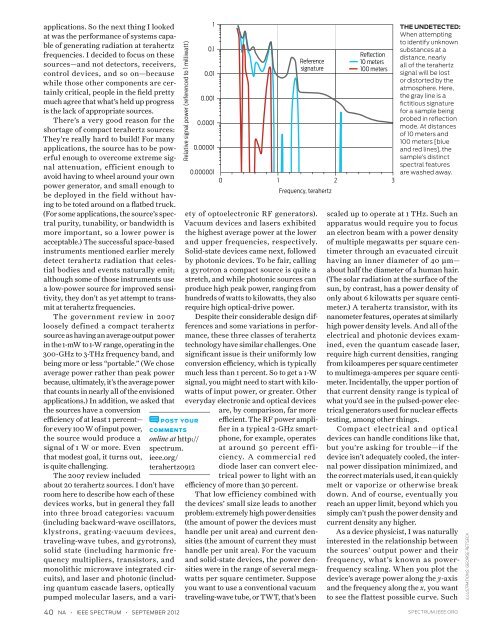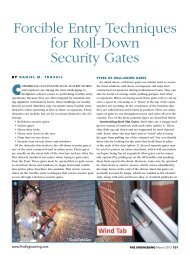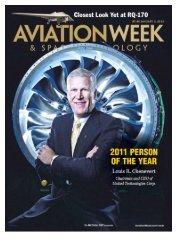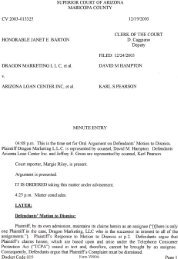The Truth About Terahertz
The Truth About Terahertz
The Truth About Terahertz
You also want an ePaper? Increase the reach of your titles
YUMPU automatically turns print PDFs into web optimized ePapers that Google loves.
applications. So the next thing I lookedat was the performance of systems capableof generating radiation at terahertzfrequencies. I decided to focus on thesesources—and not detectors, receivers,control devices, and so on—becausewhile those other components are certainlycritical, people in the field prettymuch agree that what’s held up progressis the lack of appropriate sources.<strong>The</strong>re’s a very good reason for theshortage of compact terahertz sources:<strong>The</strong>y’re really hard to build! For manyapplications, the source has to be powerfulenough to overcome extreme signalattenuation, efficient enough toavoid having to wheel around your ownpower generator, and small enough tobe deployed in the field without havingto be toted around on a flatbed truck.(For some applications, the source’s spectralpurity, tunability, or bandwidth ismore important, so a lower power isacceptable.) <strong>The</strong> successful space-basedinstruments mentioned earlier merelydetect terahertz radiation that celestialbodies and events naturally emit;although some of those instruments usea low-power source for improved sensitivity,they don’t as yet attempt to transmitat terahertz frequencies.<strong>The</strong> government review in 2007loosely defined a compact terahertzsource as having an average output powerin the 1-mW to 1-W range, operating in the300-GHz to 3-THz frequency band, andbeing more or less “portable.” (We choseaverage power rather than peak powerbecause, ultimately, it’s the average powerthat counts in nearly all of the envisionedapplications.) In addition, we asked thatthe sources have a conversionRelative signal power (referenced to 1 milliwatt)post yourco mmentsonline at http://spectrum.ieee.org/terahertz091210.10.010.0010.00010.000010.000001Referencesignature0 1 2 3Frequency, terahertzety of optoelectronic RF generators).Vacuum devices and lasers exhibitedthe highest average power at the lowerand upper frequencies, respectively.Solid-state devices came next, followedby photonic devices. To be fair, callinga gyrotron a compact source is quite astretch, and while photonic sources canproduce high peak power, ranging fromhundreds of watts to kilowatts, they alsorequire high optical-drive power.Despite their considerable design differencesand some variations in performance,these three classes of terahertztechnology have similar challenges. Onesignificant issue is their uniformly lowconversion efficiency, which is typicallymuch less than 1 percent. So to get a 1-Wsignal, you might need to start with kilowattsof input power, or greater. Othereveryday electronic and optical devicesare, by comparison, far moreefficient. <strong>The</strong> RF power amplifierin a typical 2-GHz smartphone,for example, operatesat around 50 percent eff i-ciency. A commercial reddiode laser can convert electricalpower to light with anefficiency of more than 30 percent.That low efficiency combined withthe devices’ small size leads to anotherproblem: extremely high power densities(the amount of power the devices musthandle per unit area) and current densities(the amount of current they musthandle per unit area). For the vacuumand solid-state devices, the power densitieswere in the range of several megawattsper square centimeter. Supposeyou want to use a conventional vacuumtraveling-wave tube, or TWT, that’s beenReflection10 meters100 metersTHE UNDETECTED:When attemptingto identify unknownsubstances at adistance, nearlyall of the terahertzsignal will be lostor distorted by theatmosphere. Here,the gray line is afictitious signaturefor a sample beingprobed in reflectionmode. At distancesof 10 meters and100 meters [blueand red lines], thesample’s distinctspectral featuresare washed away.efficiency of at least 1 percent—for every 100 W of input power,the source would produce asignal of 1 W or more. Eventhat modest goal, it turns out,is quite challenging.<strong>The</strong> 2007 review includedabout 20 terahertz sources. I don’t haveroom here to describe how each of thesedevices works, but in general they fallinto three broad categories: vacuum(including backward-wave oscillators,klystrons, grating-vacuum devices,traveling -wave tubes, and gyrotrons),solid state (including harmonic frequencymultipliers, transistors, andmonolithic microwave integrated circuits),and laser and photonic (includingquantum cascade lasers, opticallypumped molecular lasers, and a variscaledup to operate at 1 THz. Such anapparatus would require you to focusan electron beam with a power densityof multiple megawatts per square centimeterthrough an evacuated circuithaving an inner diameter of 40 µm—about half the diameter of a human hair.(<strong>The</strong> solar radiation at the surface of thesun, by contrast, has a power density ofonly about 6 kilowatts per square centimeter.)A terahertz transistor, with itsnanometer features, operates at similarlyhigh power density levels. And all of theelectrical and photonic devices examined,even the quantum cascade laser,require high current densities, rangingfrom kiloamperes per square centimeterto multimega-amperes per square centimeter.Incidentally, the upper portion ofthat current density range is typical ofwhat you’d see in the pulsed-power electricalgenerators used for nuclear effectstesting, among other things.Compact electrical and opticaldevices can handle conditions like that,but you’re asking for trouble—if thedevice isn’t adequately cooled, the internalpower dissipation minimized, andthe correct materials used, it can quicklymelt or vaporize or otherwise breakdown. And of course, eventually youreach an upper limit, beyond which yousimply can’t push the power density andcurrent density any higher.As a device physicist, I was naturallyinterested in the relationship betweenthe sources’ output power and theirfrequency, what’s known as powerfrequencyscaling. When you plot thedevice’s average power along the y-axisand the frequency along the x, you wantto see the flattest possible curve. Such40 NA • iEEE Spectrum • september 2012 spectrum.ieee.orgillustrations: George retseck
















